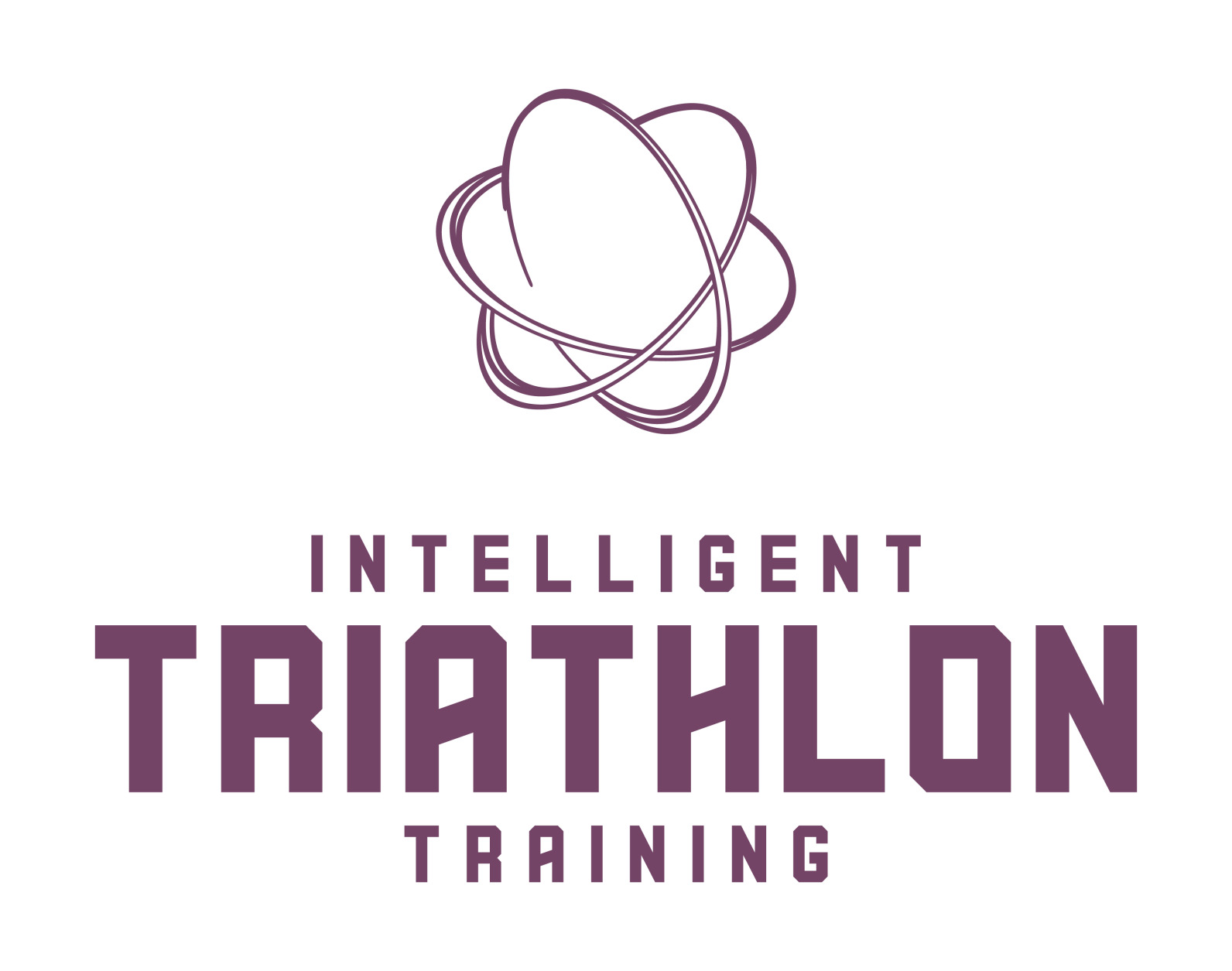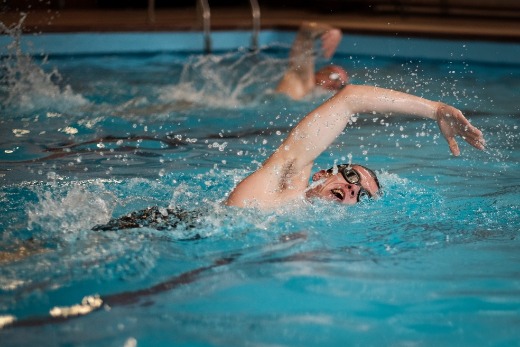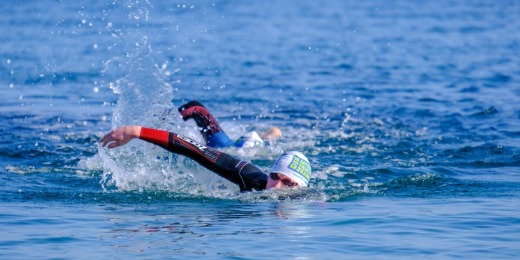Whats the Best Swim Technique for Triathlon?
 Mark Pearce
March 26, 2021
Mark Pearce
March 26, 2021
What’s the Best Swim Stroke for Triathlon?
I'll be blunt - there is no such thing as the best triathlon swim stroke – there are simply different swim strokes. Most variants have been used by successful swimmers at some point.
A more significant issue for the time-crunched amateur swimmer is what is MY best stroke?
It might be refining your current stroke, or it may mean adopting a different technique, such as a straight arm recovery which is often associated with open water as it means the hands never clip the surface of the water. However, sometimes this just hides more serious issues with the stroke such as insufficient rotation. Anyway, I am getting ahead of myself!
How do you define a good swim stroke?
We can all look at perfect models of swim technique and try to aspire to that, but will it work for you, and will it make you faster?
Possibly not.
Does that mean you should not try? Of course not.
To change technique requires two key ingredients before we even get into what we need to do.
- Time – a technique in something as complicated as swimming rarely changes in a session or two. It is a slow evolution over time.
- Enthusiasm - because point 1 takes time, you must be dedicated to making it happen, you need to practice a lot, you need to be prepared to go backwards before you go forward – you must be engaged in the process of becoming a more efficient swimmer.
This begs the question – will it be worth it?
If you have the right ingredients and you have:-
- Time
- Enthusiasm
- Quality coaching
Then yes it will be.
Most amateur triathlon swimmers are fit people, cardiovascularly your body does not know the difference between swim, bike and run.
If you have a high VO2max and you train a lot, then you are likely to have the O2 carrying capacity which means you can deliver a large volume of O2 to the muscles and extract it, turning it into energy.
However, we have all seen very ‘fit’ people get in the water and work hard but go nowhere fast.
First, they do not have the specific muscle conditioning that would enable them to do rep after rep, but more importantly, they do not have the coordination to move through the water efficiently. It is like riding a bike but sitting upright catching the wind. Even the fittest person will go slowly compared to someone in an aerodynamic position.
Swimming is similar except that water is much denser than air so, any unnecessary resistance is going to slow you down or increase the energy cost needed to overcome that resistance. There are also no fixed points to help with balance, you are suspended in water, you cannot use the ground for reference or set your position.
Efficiency is hard to obtain though. Everyone can work their arse off in a ‘training’ session, but at some point, you will inevitably hit a ceiling to your performance; your fitness will not allow you to go any faster, because you cannot overcome the limitations of your efficiency.
So, you have 2 choices
- Accept that this is where you swim – and you can rely on an x swim in your event
- Spend time working on your efficiency.
I often get asked ‘but what will happen to my fitness if I focus on technique’?
I often get asked ‘but what will happen to my fitness if I focus on technique’?
If you are fit, you are fit – you just need to refine your specific swim fitness. COVID has shown us that you can be out of the water for months, and within weeks be back to a similar level. So, if you spend a few off-season months working on technique, how much faster do you think you will be able to swim?
Technique training is also generally less fatiguing than big hard swim sets, so you will have the energy to improve the more physiology orientated disciplines, and even raise your physiological ceiling so when you are more efficient and fitter, you will FLY!
There is a lot of advice about the ‘BEST” swim stroke out there, and for every example of someone with a particular style swimming fast, there will be another example of someone doing it completely differently. The point is there is NOT a single correct technique. Even with similar basics swimmers can look quite different - do not get misled by the aesthetics of a stroke, there is more to swim stroke than just what the arms are doing.
Having said that there are some fundamental areas that need to work effectively, and within those, there can be a degree of variation.
I break the swim stroke down into two key areas:-
- Drag
- Propulsion
DRAG
Refers to aspects of the stroke which increase the size of the hole that the swimmer has to go through, thus increasing resistance. The depth and angle of the body in the water account for a lot of the resistance encountered. A flat but low body position will mean a greater hole to swim through, as will the classic sinking feet or hips situation. Twisting from side to side will increase the width of that hole.
There is another aspect to drag as well which is turbulence. The best example of this is not pointing your toes. Ideally, as the leg moves down we want the top of the foot and the shin to create a straight line, so the top of the foot is pressing on the water.
This pushes water backwards. If the toes or foot are not pointed, and instead ‘dig’ into the water, then there will be turbulence behind and in front of the foot creating drag. Also because the downward

PROPULSION
Propulsion Is primarily about the arms and how effective are they at generating propulsion, and areas such as the timing of the stroke will impact that . The kick is also included here, as there is a small amount of propulsion from an effective kick. However more often we look at the kick as a cause of drag, as swimmers with poor kick control will create added resistance.
It is at this point that I see many swimmers going wrong. I’ve just said the arms create the propulsion, and many swimmers will go straight to this point in order to improve their stroke. However, the arms can ONLY provide effective propulsion if the rest of the body is set up for that.
Anyone play golf or had lessons? Lesson 1 is NOT about how to hit the ball, correct? It might be able how to stand, where to put your feet, how to hold the bat (sic), it’s most certainly NOT about picking the biggest club up you can find and trying to welly the ball as far as you can (however much fun that might be).
Swimming is no different, if you want to learn to swim effectively you need to be able to put yourself in the position to be able to propel yourself effectively, which means minimising drag as well.
What you must remember is that all the aspects of the stroke are connected and if you change something it will inevitably have a knock-on effect somewhere else.
One of my pet hates is the social media posts about ‘get a great catch’ for instance. If you do not have the basics in place a great catch is not really going to help, nor will develop your catch first!
Some key actions that affect drag and propulsion:
Drag
- Sinking feet/hips
- Deep but flat position
- Torso twisting off a central axis?
- Feet kicking out?
Propulsion
- Does the catch phase get purchase on the water?
- Does the elbow remain above the wrist?
- Does the alignment result in water being pushed behind, not sideways?
- Is the stroke finished effectively?
- Is the kick creating propulsion?
- Or not creating drag – for those with a minimal kick
For example – a common problem is sinking feet with low hips and lower feet. This creates drag all the way along the swimmer's full length and means that the hole the swimmer needs to through is much larger. If this swimmers' solution to going faster is to work on their catch (how the hand/arm holds the water at the start of the propulsive phase) it's probably not going to work very effectively!
If they improve their catch, they are still going to have to use a huge amount of energy to overcome the drag that is still present, and this is probably not within their capability. The swimmer needs to reduce their drag by raising their hips and feet first, then possibly thinking about how to hold more water.
Another issue with this may be that their rotation is not correct. If you work on improving the arm action, and then the rotation, the effect will be that with more rotation the arm and hands will be in unusual positions, so you will have to go back and repeat this with the new rotation.
So, there is an order to how things should be developed. Of course, perfection in one is not needed before moving on, but improvements should be sought, then you can come back to it and try to improve it again. Repetition of this will lead to improvements in technique.
Within the main PROPULSION and DRAG categories, there are several factors that will influence one or both of these. These are the areas to consider when thinking about how to resolve issues with Propulsion or Drag.
To create propulsion, you must move water backwards, if you press down on it, you are lifting in a vertical direction. This creates a lot of work or expends a lot of energy for ZERO propulsion. It also shortens your opportunity to create meaningful propulsion as your arm will be midway through the stroke before it starts to create propulsion.
Summary
What I have described here sounds very specific but in reality, there is a degree of flexibility within most areas that will mean most swimmers will look slightly different from each other.
I am most certainly not a fan of trying to get everyone swimming the same or doing anything else the same for that matter. The point here is that for safe, effective swimming certain things need to happen, but everyone's unique skills, body proportions, the experience will mean this works slightly differently.
However, what you do need is a plan! There are a variety of swimming 'systems' out there, that DO teach you to be the same as every other swimmer. Some have success and they also fail, this is because you are UNIQUE and need to find the approach that works for YOU.
If you are interested in finding our more about how we go about improving technique, and what is involved in each of these areas, we have or will be having a lot more information on our website and in our training sessions.




